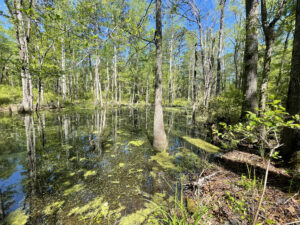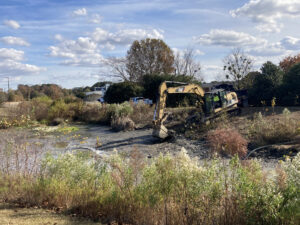News
Riverkeeper Spotlight: County board says no to proposed subdivision near open hog lagoon
Posted on May 19th, 2022

It’s a WIN in Johnston County!
This week, Neuse Riverkeeper Sam Krop attended a public hearing to speak to the Johnston County Planning Board about a proposal to build a subdivision on the site of an old hog CAFO where an open hog-waste lagoon remains.
The operation was open until the mid-1990s, but closed after receiving violations for illegal discharge into nearby waterways. There is no record of the owners getting the proper permits to close the facility; it appears the owners depopulated the farm and never officially closed out or cleaned out the waste lagoon, Sam said.
A developer proposed turning an adjacent tract into a subdivision with 38 homes that would have likely dumped stormwater into the wetlands, directly down a steep slope, where the lagoon remains open.
The lagoon is in the 100-year floodplain and directly adjacent to a tributary which runs from a freshwater pond to the northeast, directly into Black Creek, a tributary of the Neuse.
After hearing from Sam and other residents, the Johnston County Planning Board voted unanimously to deny the development based on concerns about the open hog lagoon.
Read what Sam had to say to Planning Board members:
Thank you for the opportunity to speak with you today. My name is Samantha Krop, I am the Neuse Riverkeeper with Sound Rivers, a nonprofit that works to protect, monitor and enhance the Neuse and Tar-Pamlico River watersheds.
As the Neuse Riverkeeper, I am a full-time river advocate who monitors and protects the river, and I serve as a scientific and educational resource to all the people living in the watershed.
My comment is on the Helen Stephenson Tract Subdivision plan. As a waterkeeper, my primary concerns with this development center on its impacts to the surrounding Black Creek watershed and the health and wellbeing of those who rely on it.
The preliminary proposal presented by the developer to the Planning Board fails to identify the site of an old hog-waste lagoon in the southwest portion of the property, located in the 100-year floodplain and adjacent to a blue line tributary that pours into Black Creek. The lagoon, and the tributary that runs alongside it, are visible using satellite imagery of the area, but are not acknowledged in the preliminary planning documents for the Stephenson tract development.
According to DEQ records, the lagoon was in operation for about 20 years and was the primary means of waste storage for hundreds of hogs on the property. A 1995 site visit of the property revealed that the hog-waste lagoon was actively discharging into the nearby waterway, which resulted in an official Notice of Violation being issued in early 1996. Rather than address the discharge issue and come into compliance with required permits, the operator chose to depopulate their farm of hogs. While there have been no hogs on the farm since then, there is no record that the operator took the necessary steps to properly close out their hog waste lagoon, so it is quite likely that existing waste still resides in that lagoon and possibly continues to contaminate nearby waterways in heavy rain events.
I am sure that the Planning Board is aware that the Department of Environmental Quality currently has an open investigation regarding this hog lagoon, which to my knowledge is yet unresolved. Without closure from this investigation, we have no way of knowing whether this hog lagoon continues to be a source of pollution, or what measures the developer will need to take to remediate this unfortunate issue that they have inherited.
Converting the 58 acres of rain-permeable surface that currently makeup this property to 32 subdivided lots with impermeable roads, driveways and rooftops, will increase the volume of stormwater runoff coming from this property and exacerbate any ongoing pollution flowing from the unresolved waste lagoon into Black Creek. The very steep gradient coming down from the proposed lots to the floodplain almost ensures that this additional runoff will be directed through the wetland surrounding the hog lagoon and into Black Creek, and eventually, the Neuse River.
The NRCS conservation practice standards governing a waste facility’s closure are intended to protect the quality of surrounding surface water and groundwater resources, mitigate air emissions and eliminate safety hazards for humans and the general public. The existence of this unpermitted, unregulated hog-waste lagoon continues to be a safety hazard until it is properly dealt with.
Waste from swine lagoons is a source of pollution to the local environment and adversely affects soil, surface water and groundwater quality. Swine waste contains large amounts of nutrients such as nitrogen, phosphorus, and microorganisms such as E. coli, Salmonella and also antibiotics, hormones and feeding additives such as copper and zinc.
One of the primary ways that local water environments become polluted is by heavy rains and floods that wash pollutants into nearby surface waters. This added pollution challenges aquatic life by contributing to excessive algal blooms, low levels of dissolved oxygen, large fish kills and outbreaks of toxic microorganisms. This is specifically an issue for the Neuse River, which is listed as impaired for nutrient overloads. This toxic pollution can also pose a threat to humans who interact with or drink the water.
Waste lagoons that reside in the floodplain are increasingly more vulnerable to overtopping or breaching during a hurricane or prolonged storms. According to North Carolina’s most recent Climate Science Report, we can expect heavy rains from hurricanes and other weather systems to become more frequent and more intense in coming years, and annual precipitation is also expected to increase. The fact that this hog-waste lagoon is in the 100-year floodplain today, makes this matter ever more urgent to address, as we can expect these flood events to become more frequent in the future.
In my professional opinion, there are too many unknowns as a result of the unresolved open waste lagoon on the property for the safe and responsible approval of this development. We do not know if the lagoon continues to hold waste or if it is overflowing and contaminating the nearby wetland and Black Creek. Furthermore, we do not know if the developer plans to close out the lagoon, or how that process would be completed. We do not have any stormwater plans that suggest how the developer will avoid increased runoff from the conversion of these permeable surfaces to impervious surfaces, or if the developer is even willing to accept the responsibility of taking the necessary steps to avert increased pollution to the watershed.
I am concerned that without these assurances in place, the developer will be simply continuing the legacy of unpermitted pollution of this wetland and Black Creek.
Chapter 14 of the Johnston County County Land Development Code states that the intent is for subdivided lots to be used safely without danger to the health, safety and general welfare of prospective or future owners in the county’s community.
The existence of this open waste lagoon on the property, with so many unanswered questions regarding its closure, make it impossible for the Planning Board to assure the health, safety and general welfare of the community or surrounding environment with the information offered in this preliminary plan.
To make an informed decision, please deny this proposal pending DEQ’s conclusion of their investigation and a sufficient plan from the developer to adequately close out and mitigate further impacts caused by this open waste lagoon.
Related News

Riverkeeper weighs in on Raleigh tap-water woes
April 25th 2024

Small cleanup, with a big impact
April 25th 2024

New math moves parts of the Pamlico off impaired waters list
April 25th 2024

Durham turns down Lick Creek development
April 25th 2024

Scout earns volunteer hours with trash trap cleanout
April 25th 2024

Boat day a Blounts Creek exploration
April 25th 2024

Tell NC to restore wetlands protections!
April 19th 2024

Position available: Stormwater Education Coordinator
April 18th 2024

